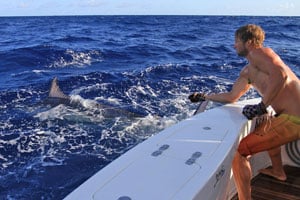IGFA - Peter Teakle Wins 2013 IGMR
|
OCTOBER 2013 -- With 30 satellite tags deployed in blue marlin, black marlin, and sailfish in six countries, the second year of the IGFA Great Marlin Race (IGMR) has come to a close. The IGFA’s billfish research program, working in collaboration with Stanford University, held seven tagging events in 2012-2013 that tracked a total of 17,059 nautical miles (nm) on imperiled billfish species worldwide, covering more than 5,000 nm more than the previous year. Every fish track is available to the public and to researchers to help them learn more about billfish, but the fish that travels the farthest is crowned the annual IGMR winner. This year’s winning fish was a 360 kg (794 lb) black marlin outfitted with a satellite tag sponsored by Peter Teakle during the 26th Annual Lizard Island Black Marlin Classic in Australia, which travelled 2,577 nm – 15% of the total distance recorded in the entire year – before the tag popped up after 69 days.
|

The winning black marlin being brought alongside Kekoa to be tagged during the IGFA Great Marlin Race off of Lizard Island, Australia. Photo courtesy of Kelly Dalling Fallon of www.blackmarlinfishingblog.com.
|
“That we’ve now seen the second longest distance of the IGMR project is amazing,” said IGMR co-chair and Stanford University marine biologist, Dr. Randy Kochevar. “But the real win here is that in the past two years we have recorded a total of 31,000 nautical miles worth of data on open-ocean habitat usage available for scientists anywhere. Having access to this kind of data is what researchers need in order to better understand how these incredible animals are using the open ocean.”
|
|
The longest track in IGMR history belonged to last year’s winner, a tag that travelled a whopping 4,776 nm and was sponsored by Trevor Somny, Bruce McKee, and Bill Crawford during the Club Nautico de San Juan 58th Annual Billfish Tournament, held in Puerto Rico September 5-11, 2011. This year’s winning tag was deployed on November 11, 2012 by Chase Hooper aboard Kekoa at Spur Reef. The angler, Scotty Taylor, described the fish as being in “excellent condition.”
The second place tag of this race year belongs to an 82 kg (180 lb) blue marlin that swam 1,743 nm in only 87 days. Co-sponsors Ralph Czabayski and Rolf Czabayski, who also caught the fish and deployed the tag during the 53rd Annual Hawaii International Billfish Tournament in Kona, Hawaii on August 13, 2012, stated that they are “proud to be involved in the satellite tagging program.” To date, this distance is the third longest track recorded in the IGMR.
“We have already been able to implement this data to better protect billfish populations,” observed IGMR co-chair and IGFA Conservation Director Jason Schratwieser. “Being able to demonstrate the incredible distances these fish travel helped us lobby for the passage of the Billfish Conservation Act in the United States late last year. The next challenge will be how to reverse the population declines of some of these species. Making this data available to researchers and fisheries managers worldwide is an integral part of solving that problem.”